Istanbul: Truth or Myth? 30 Surprising Facts About the City Between Continents
Istanbul — the city where Europe and Asia meet — is full of glittering mosques, noisy bazaars, and ferries crossing the Bosporus. But behind the postcard views, the city also hides stories that sound too strange to be true. Some are rooted in history, others are pure legend.
That’s why I started this Truth or Myth series: to collect the facts, the fables, and the fun details that make a city feel alive. I like to wander with wonder — not just ticking off attractions, but pausing to ask: did that really happen?
So here it is: 30 surprising facts about Istanbul. Some you’ll find in guidebooks, others you’ll only hear whispered in tea houses or local stories. And a few? Well, they might just be myths…
Can you tell the difference? Let’s find out.
Here’s where the stories unfolded for me in Istanbul:
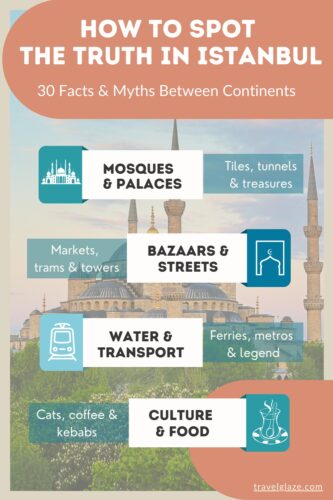
Save this pin on pinterest
🕌 Mosques & Palaces
Does the Blue Mosque really have over 20,000 blue tiles?
✅ True! The Sultan Ahmed Mosque, better known as the Blue Mosque, was built in the early 1600s and its interior is lined with more than 20,000 hand-painted Iznik tiles. Most are shades of blue, which give the mosque its popular nickname. The patterns include flowers, tulips, and geometric designs that shimmer when sunlight filters through the windows.
💡 Fun fact: The mosque actually has six minarets — a number that once caused controversy, since only the Great Mosque in Mecca had the same. To solve the dispute, the sultan funded a seventh minaret for Mecca.
📍 Location: Sultan Ahmet, Atmeydanı Cd. No:7, Fatih/İstanbul
Was Hagia Sophia the world’s largest church for almost 1,000 years?
✅ True! When it was completed in 537 AD under Emperor Justinian, Hagia Sophia was the largest church in the world. Its massive dome, 31 meters across, seemed to float in the air — an engineering marvel of its time. It held the record until St. Peter’s Basilica in Rome was completed in the 16th century.
💡 Fun fact: The name “Hagia Sophia” means “Holy Wisdom,” not Saint Sophia as many assume.
📍 Location: Ayasofya Meydanı No:1, Fatih/İstanbul
Do the ceilings of Dolmabahce Palace shine with 14 tons of gold leaf?
✅ True! Built in the 19th century to show Ottoman wealth and European taste, Dolmabahce Palace is famously lavish. Its ceilings and decorations used around 14 tons of gold leaf. The palace also houses one of the largest crystal chandeliers in the world, weighing 4.5 tons.
💡 Fun fact: Mustafa Kemal Atatürk, founder of modern Turkey, spent his last days in Dolmabahce. The clock in his bedroom is still stopped at the time of his death in 1938: 09:05.
📍 Location: Vişnezade, Dolmabahçe Cd., Beşiktaş/İstanbul
Is there a secret tunnel from Topkapi Palace to the Bosporus?
❌ Myth! Stories have long circulated about hidden passages running from Topkapi Palace down to the shore, used by sultans to slip out unseen. While small service tunnels do exist, no large escape route to the Bosporus has ever been proven.
💡 Fun fact: The palace complex was designed more like a small city than a single building — with its own kitchens, hospital, library, and barracks.
📍 Location: Cankurtaran, 34122 Fatih/İstanbul
Did elephants once live in the palace gardens?
✅ True! The Ottoman sultans kept exotic animals as part of their menageries, both to entertain guests and to show the empire’s reach. Records mention elephants, lions, and even giraffes being kept in palace grounds at different times. While the animals were symbols of power, they were also gifts from foreign rulers.
💡 Fun fact: Exotic animals were such a curiosity that sometimes they were paraded through the streets of Istanbul to impress the public.
📍 Location: Topkapi Palace, Dolmabahce Palace (historic records)
🛍️ Bazaars & Streets
Is the Grand Bazaar the world’s oldest shopping mall?
✅ True! The Grand Bazaar (Kapalıçarşı) dates back to the 15th century, when Sultan Mehmet the Conqueror ordered its construction shortly after the Ottoman conquest of Constantinople. With over 60 covered streets and more than 4,000 shops, it’s often described as the world’s first shopping mall.
💡 Fun fact: Around 250,000–400,000 people still visit daily, making it one of the busiest markets in the world. There’s even a mosque, a post office, and several banks inside.
📍 Location: Beyazıt, Fatih/İstanbul
Does the Spice Bazaar sell only spices?
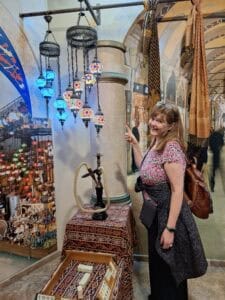
❌ Myth! Although piles of saffron, pepper, and sumac look stunning, the Spice Bazaar (Mısır Çarşısı) sells much more: dried fruit, nuts, teas, Turkish delight, and even jewellery. Built in the 17th century as part of the New Mosque complex, it’s smaller and easier to explore than the Grand Bazaar.
💡 Fun fact: The name “Egyptian Bazaar” comes from the fact that it was originally funded with taxes collected in Egypt, then an Ottoman province.
📍 Location: Rüstem Paşa, Erzak Ambarı Sok. No:92, Fatih/İstanbul
Does Istiklal Street’s red tram run on original 19th-century tracks?
❌ Myth! The nostalgic red tram is a heritage line, but the original trams stopped in the 1960s. The line was reintroduced in 1990 to bring back the charm of old Istanbul. The current route is shorter than the historic one but still beloved for its retro look.
💡 Fun fact: The trams are so popular that they’ve appeared in countless Turkish films and postcards. Don’t be surprised if you see kids jumping on the back for a free ride — a local tradition.
📍 Location: Runs from Taksim Square along Istiklal Cd. to Galata
Was the Galata Tower once used for flying experiments?
✅ True! In the 17th century, Hezarfen Ahmed Çelebi is said to have strapped on wings and flown from the Galata Tower across the Bosporus to Üsküdar on the Asian side. While it may not be fully proven, Ottoman records mention the attempt, and today he’s remembered as a pioneer of flight.
💡 Fun fact: The Galata Tower is still one of the best viewpoints in the city, though recently it has often been closed for renovations — always check before you go.
📍 Location: Bereketzade, Galata Kulesi Sok., Beyoğlu/İstanbul
Was there really a law requiring ladies to wear gloves on Istiklal Street?
❌ Myth! While 19th-century European visitors often strolled along Istiklal Street in full aristocratic attire, there was never a legal requirement for women to wear gloves. This idea likely comes from the strict etiquette of the time, not actual Ottoman law.
💡 Fun fact: In Ottoman days, Istiklal was called “Grande Rue de Péra” and was the center of European-style life in Istanbul, with embassies, theatres, and cafés.
📍 Location: Istiklal Avenue, Beyoğlu
🌊 Water & Transport
Can you cross continents by metro in under 2 minutes?
✅ True! The Marmaray metro line runs under the Bosporus Strait, connecting the European and Asian sides of Istanbul. The underwater tunnel opened in 2013 and is one of the deepest immersed tube tunnels in the world. The journey itself takes just 90 seconds — shorter than most ferry rides across the strait.
💡 Fun fact: At rush hour, the Marmaray can feel as busy as a bazaar, carrying up to 75,000 passengers per hour.
📍 Location: The line runs from Halkalı (Europe) to Gebze (Asia).
Is the Bosporus the narrowest strait used for international shipping?
✅ True! At its narrowest point, near Rumeli Fortress, the Bosporus is just 700 meters wide. Despite this, it’s one of the busiest waterways in the world, with thousands of cargo ships passing each year. Pilots are required for large vessels, but accidents have still occurred over the centuries.
💡 Fun fact: Some days you might see enormous oil tankers pass by small fishing boats — a surreal mix of local life and global trade.
Was the Maiden’s Tower built to protect a princess from a snake bite?
✅ Legend says so! According to Ottoman folklore, an emperor locked his daughter inside the Maiden’s Tower (Kız Kulesi) after hearing a prophecy that she would die from a snake bite. Sadly, a snake hidden in a fruit basket still sealed her fate. The tower has served as a lighthouse, customs station, and café over the centuries.
💡 Fun fact: Today it’s one of Istanbul’s most romantic spots, often used for proposals.
📍 Location: Small islet at the southern entrance of the Bosporus, near Üsküdar (Asia).
Did the Basilica Cistern once hold snakes to guard the water?
❌ Myth! The Basilica Cistern was built in the 6th century to store water for the Great Palace. While the dim atmosphere has inspired countless legends — snakes, crocodiles, even ghosts — there’s no evidence animals were ever used as guards.
💡 Fun fact: Its fame grew after appearing in movies like From Russia with Love (James Bond) and Inferno (Dan Brown).
📍 Location: Alemdar, Yerebatan Cd. 1/3, Fatih/İstanbul
Is there a metro station 72 meters underground.
✅ True — Gayrettepe Station and Yıldız Station are among the deepest in Istanbul, but exact figures vary by source. Some claim depths of 70–80 meters. Either way, Istanbul’s metro system is among the steepest and deepest due to the city’s hilly geography.
💡 Fun fact: Escalators here can feel endless — the longest in Istanbul stretches over 60 meters.
📍 Location: Line M11 and M7
🎭 Culture & Traditions
Does Istanbul really have more than 3,000 mosques?
✅ True! With its skyline dotted by domes and minarets, Istanbul is home to more than 3,000 mosques — more than any other city in Turkey. Some are monumental, like the Blue Mosque or Süleymaniye, while others are small neighborhood mosques tucked between shops and homes.
💡 Fun fact: The call to prayer (ezan) echoes across the city five times a day. While mosques follow the same schedule, the sound doesn’t always start at exactly the same second — creating a wave of voices across the rooftops.
Are cats officially protected as part of the city’s heritage?
✅ True! Cats are everywhere in Istanbul — in mosques, on café chairs, even in museums. Locals feed and care for them, and they’re considered part of the city’s culture. A 2016 documentary (Kedi) made Istanbul’s street cats famous worldwide.
💡 Fun fact: Even in Hagia Sophia, you might meet Gli, a famous resident cat who lived there for 16 years and had her own Instagram following.
Are whirling dervishes only a tourist show?
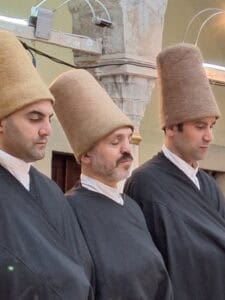
❌ Myth! While many visitors attend performances, the whirling dance (Sema) is a religious ritual of the Mevlevi Order, dating back to the 13th century. The spinning represents a spiritual journey towards closeness with God. The fact that tourists can witness it today is part of Turkey’s effort to preserve and share this heritage.
💡 Fun fact: In 2008, UNESCO recognized the Mevlevi Sema ceremony as part of the world’s Intangible Cultural Heritage.
Did tulips really come from the Netherlands?
❌ Myth! Tulips are strongly linked with the Netherlands, but the flower originated in Central Asia and was cultivated in the Ottoman Empire long before it reached Europe in the 16th century. In fact, the early 1700s in Ottoman history is even called the “Tulip Era.”
💡 Fun fact: Today, Istanbul still hosts a Tulip Festival every spring, planting millions of bulbs across parks and squares.
Were evil eye charms (nazar boncuğu) first produced in Istanbul?
❌ Myth! The blue glass charms known as nazar boncuğu are deeply tied to Turkish culture, but their exact origin is debated. The tradition of the evil eye amulet dates back thousands of years to ancient civilizations in the Middle East and the Mediterranean, including Mesopotamia and Anatolia. The specific blue glass design that is so popular today became widespread in Anatolia (modern-day Turkey), especially as glassmaking developed in the region. However, there is no historical evidence that the first production took place in Istanbul itself—rather, Istanbul has played a significant role in popularizing the charm as a souvenir, but production started earlier in other Anatolian and Mediterranean locations.
💡 Fun fact: You’ll spot these charms everywhere in the city — from market stalls to buses and even baby strollers
🍴 Food & Markets
Is simit (the sesame bread ring) really called the “Turkish bagel”?
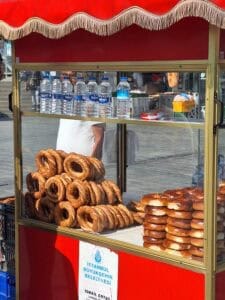



Was Istanbul the birthplace of döner kebab?


Did Istanbul have the world’s first coffeehouses?


Are the fish sandwiches at Galata Bridge a century-old tradition?
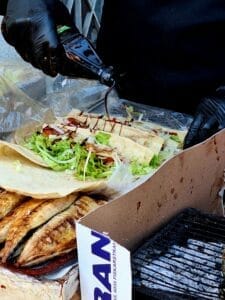


Does the Grand Bazaar have its own post office and mosque inside?


🎉 Fun & Surprising
Is Istanbul the only city in the world built on two continents?
✅ True! Istanbul is famously split by the Bosporus Strait, with part of the city in Europe and part in Asia. Ferries, bridges, and even an underwater metro connect the two sides daily.
💡 Fun fact: Around 65% of the city’s population lives on the European side, but many commute daily across continents for work or school.
Do more people live in Istanbul than in 20 EU countries combined?
✅ True! Istanbul’s official population is over 15 million, but estimates suggest the real number may be closer to 17–18 million. That’s more than the entire population of countries like Portugal, Greece, or Sweden.
💡 Fun fact: If Istanbul were a country, it would be one of the 20 most populous in the world.
Were the Steps of Constantinople built to test soldiers’ stamina?
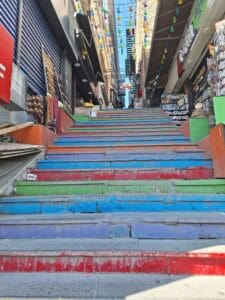
❌ Myth! These colourful staircases, often decorated with murals and rainbow paint, are modern creations. Some became famous on Instagram, but there’s no historical record of them being used for military training.
💡 Fun fact: The most famous rainbow stairs, in Cihangir, were painted by a retired engineer in 2013 as a gift to his neighbourhood.
Has Istanbul really hosted Formula 1 races on one of the trickiest circuits?
✅ True! Istanbul Park, opened in 2005, is considered one of the most challenging F1 tracks. With fast corners and dramatic elevation changes, “Turn 8” became legendary among drivers. Although races have been on and off the calendar, the circuit remains highly respected.
💡 Fun fact: Some drivers call it a “rollercoaster ride” — proof that Istanbul isn’t just about history but also modern thrills.
Do all mosques in Istanbul call to prayer at exactly the same time?
❌ Myth! The call to prayer (ezan) happens five times a day, following the same schedule, but mosques don’t always begin at the exact same second. The result is a beautiful wave of voices that rolls across the city, especially striking at sunset.
💡 Fun fact: Many visitors describe this layered chorus as one of their most moving memories of Istanbul.
👉Final Thoughts
Istanbul is a city where every step tells a story — from its ancient cisterns to its modern skyline. Whether you’re walking under Metros, listening to the call to prayer ripple across two continents, or spotting street cats with more followers than you, the city never stops surprising.
It’s not just the monuments that make Istanbul special — it’s how the everyday, the myth, and the unexpected blend together. That’s what makes it a true Travelglaze destination. So whether you’ve already been or are planning a trip, take a little time to wander with wonder.
Have you heard a surprising Istanbul story — a myth or a little-known fact? Or maybe you found your own hidden corner of the city? I’d love to read your discoveries in the comments below!


